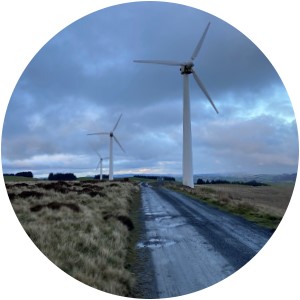
Cairn Duhie is a proposed 16-turbine wind farm in the Scottish Highlands. Since gaining project consent in 2017, the site layout has been redesigned to accommodate updated turbines. Application for the proposed redesign is expected to be submitted within 2020.
Pushing for clean energy
The Scottish government’s target is for 50% of Scotland’s energy consumption to come from renewable sources by 2030. The Cairn Duhie wind farm is expected to contribute significantly to this.
As with all wind farm developments, an Environmental Impact Assessment (EIA) is a required part of the Cairn Duhie planning process, to investigate and mitigate any potential impacts on the existing environment.
A number of issues are covered, including:
- landscape and visual
- ornithology
- ecology
- hydrology
- hydrogeology and geology
- archaeology and cultural heritage
- traffic and transport
- noise
The role of WHS
WHS was commissioned to provide input into the Cairn Duhie EIA, beginning our work in 2013. We have stayed with the project to date.
Our commission was to produce the geology, hydrology and hydrogeology elements of the EIA, including assessing the baseline environment and determining potential impacts upon the environment.
A key part of our involvement in the project included the production of a hydrological features and constraints map to inform the project’s proposed layout.
The map included:
- an exclusion zone in the vicinity of surface-water features
- private water supplies
- wetlands (GWDTE)
- areas of steep slopes to avoid, because of the potential for increased sediment mobilisation.
Key elements of our input
Baseline assessment
- A desk-based assessment to inform the baseline description of the site, focusing on the water environment, including water quality and water resource utilisation.
- Review of local mapped features, flood risk, and identification of water supplies.
- A hydrological constraints map.
Flood risk assessment and SuDS design
- Identification and review of the site’s flood-risk sources including fluvial, surface water, groundwater and reservoir flood risk.
- An outline drainage design for the proposed site layout. This details how to manage surface water drainage appropriately during the construction and operational phases of the wind farm, to minimise the impact of surface water runoff from the development.
- Design of swales to limit flow velocities during extreme storm events, and design of settlement ponds as permanent ponds with sufficient volume to treat runoff from 90% of rainfall events.
- Identification of under-road drains and discharge points, to ensure natural flow paths on site are maintained.
Private water supply risk assessment
- Consultation with the Highland and Moray Councils, which revealed private water supplies in the sub-catchments draining from the site.
- Review of the potential impacts of the proposed development on these water sources.
- Identification of the potential for temporary changes in water quality through sedimentation and changes to instream hydrochemistry during the construction phase. These changes may arise through ground disturbance resulting in increased sediment supply and mobilisation of disturbed peat sediment into the stream network.
- Assessment of the potential for accidental spillage of chemicals, hydrocarbons and other construction materials.
- Risk assessment for individual supplies, requiring definition of each supply’s zone of contribution, and proposed mitigation measures such as exclusion zones, SuDS to minimise erosion and pollution, and runoff and sediment control measures.
Carbon balance assessment
- Calculation of the carbon emission savings and carbon payback of the proposed wind farm using the results of the site Peat Survey along with the Scottish Government Carbon Calculator Tool.
- Discussion of the potential carbon savings and costs associated with the proposed development. This includes carbon emission savings, loss of carbon due to construction, loss of carbon from backup power generation, loss of carbon-fixing potential of peatland, loss and/or saving of carbon stored in peatland, carbon saving due to improved habitats and loss/or saving of carbon-fixing potential as a result of forestry clearance.
Public Inquiry as an expert witness
- WHS acted as expert witness at the 2016 public hearing with respect to the EIA’s findings on private water supplies.
The last word
Our final EIA chapters were submitted to the client in November 2020.
The planning application is expected to be submitted imminently.